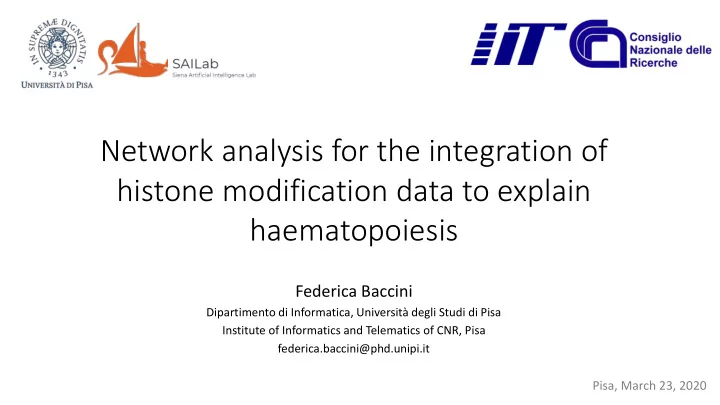

Network analysis for the integration of histone modification data to explain haematopoiesis Federica Baccini Dipartimento di Informatica, Università degli Studi di Pisa Institute of Informatics and Telematics of CNR, Pisa federica.baccini@phd.unipi.it Pisa, March 23, 2020
Outline • Introduction to epigenetics and haematopoiesis • Experimental analysis and methods: • Data description and processing • Hypothesis testing model • Results • Conclusions and further work 2
What is epigenetics? All the cells have same DNA… … but there are many types of different cells REGULATION OF GENE EXPRESSION THROUGH MODIFICATIONS EPIGENETICS 3
Histone modifications Histones are protein complexes around Histones and, predominantly, their N-tails, which DNA binds. They allow DNA to can be subject to chemical modifications assume a compact structure (chromatin), that can act as promoters or inhibitors of and to finally organize into chromosomes. gene expression. 4
The process of haematopoiesis Haematopoietic (multipotent) stem cell Progenitors (oligopotent) Differentiation capability and self-renewal Precursors (MEP and GMP) Proliferation capability Mature cells 5
Challenges to the classical model • Studies have highlighted that the myeloid potential is maintained in both the lymphoid and myeloid lineages. Questions: • Does Epigenetics play a role in the process of haematopoiesis? • Is it possible to build a model for testing the classical hypothesis on the first hierarchical subdivision? 6
Outline and dimensionality reduction EXTRACTION OF SIMILARITY GRAPH CUT FOR COLLECTION OF PEAKS OF HISTONE NETWORK HYPOTHESIS EPIGENOMES MODIFICATIONS ANALYSIS TESTING 6 matrices 7 graphs with ~5TB of dimension 24 vertices 24 × 21,987 DATA DIMENSIONALITY REDUCTION 7
Data collection and organization-1 # of cellular types : 24 # lymphoid: 11 # myeloid: 13 1 Source of the data: https://epigenomesportal.ca/ihec/ 8
Data collection and organization-2 • Epigenomes record the intensity of 6 histone modifications: • H3K27ac • H3K27me3 • H3K36me3 • H3K4me1 • H3K4me3 • H3K9me3 • Samples from diseased donors were filtered out. 9
Counting peaks per gene • Computation of peaks of each histone modification in every epigenome . • Count of the number of peaks per gene 2 in each sample (# genes considered: 21,987 ), for each modification. • Construction of 𝟕 matrices (one for each histone modification), where for a generic matrix 𝑵 , 𝑵 𝒋𝒌 = 𝐨𝐯𝐧𝐜𝐟𝐬 𝐩𝐠 𝐪𝐟𝐛𝐥𝐭 𝐩𝐠 𝐭𝐛𝐧𝐪𝐦𝐟 𝒋 𝐣𝐨 𝐡𝐟𝐨𝐟 𝒌 . 2 http://ftp.ensembl.org/pub/release-76/gtf/homo_sapiens/ 10
Data cleaning and construction of cell type matrices 𝑜 = #𝑡𝑏𝑛𝑞𝑚𝑓𝑡 average of 𝑛 = #𝑓𝑜𝑓𝑡 samples from the same cell 𝑦 1,1 ⋯ 𝑦 1,𝑛 𝑦 1,1 ⋯ 𝑦 1,𝑛 type ⋮ ⋱ ⋮ ⋮ ⋱ ⋮ 𝑦 𝑜,1 ⋯ 𝑦 𝑜,𝑛 𝑦 24,1 ⋯ 𝑦 24,𝑛 Construction of 6 Elimination of matrices , by averaging the «flat» genes using profiles of samples of the k-means clustering same cell type on genes profiles (dimension 24 × 𝑛 ) 11
Data cleaning: an example Heatmap of centroids for H3K9me3 Out: 𝑛𝑏𝑦 ≤ 500 12
Similarity network analysis • Similarity Network Fusion 1 is a tool that has the aim of aggregating multiple types of information collected on the same set of experimental units. 𝑦 1,1 ⋯ 𝑦 1,𝑛 𝑚 𝑦 1,1 ⋯ 𝑦 1,𝑛 1 𝑦 1,1 ⋯ 𝑦 1,𝑛 2 ⋮ ⋱ ⋮ ⋮ ⋱ ⋮ ⋮ ⋱ ⋮ 𝑁 1 = 𝑁 2 = … 𝑁 𝑚 = 𝑦 𝑜,1 ⋯ 𝑦 𝑜,𝑛 1 𝑦 𝑜,1 ⋯ 𝑦 𝑜,𝑛 2 𝑦 𝑜,1 ⋯ 𝑦 𝑜,𝑛 𝑚 SNF 𝑦 1,1 ⋯ 𝑦 1,𝑜 ⋮ ⋱ ⋮ 𝑦 𝑜,1 ⋯ 𝑦 𝑜,𝑜 1 Wang, Bo & Mezlini, Aziz & Demir, Feyyaz & Fiume, Marc & Tu, Z. & Brudno, Michael & Haibe-Kains, Benjamin & Goldenberg, Anna. (2014). 13 Similarity network fusion for aggregating data types on a genomic scale. Nature methods . 11. 10.1038/nmeth.2810.
SNF • For each count matrix, a similarity matrix , based on a scaled exponential similarity kernel , is constructed . • The six matrices are fused through a Cross Diffusion Process (CrDP) . General updating rule for the fusion of 𝑛 networks: (𝑙) 𝜉 = 𝑇 𝜉 × 𝑙≠𝜉 𝑄 𝑢 𝑈 × 𝑇 𝜉 𝑄 𝑢+1 𝑛 − 1 𝑇 → local affinity matrix 𝑄 → status matrix 14
Fused network 15
H3K4me1 16
Hypothesis testing: outline Greedy Cut algorithm to obtain the cost of the maximum cut Compare the cost of the two cuts for Construction of 6+1 measuring the distance networks goodness of the hypothesis Computation of the cost of the hypothesis cut 17
Results 𝑠𝑏𝑢𝑗𝑝 = 𝑑𝑝𝑡𝑢 𝑝𝑔 𝑢ℎ𝑓 ℎ𝑧𝑞𝑝𝑢ℎ𝑓𝑡𝑗𝑡 − 𝑛𝑗𝑜𝑑𝑣𝑢 𝑑𝑝𝑡𝑢 𝑝𝑔 𝑢ℎ𝑓 𝑛𝑏𝑦 𝑑𝑣𝑢 − 𝑛𝑗𝑜𝑑𝑣𝑢 18
Conclusions • Histone modifications may have a role in the haematopoietic cell differentiation process. • SNF + hypothesis testing strongly supports the hypothesis of differentiation into the myeloid and lymphoid lineages … • … but the similarity analysis suggests that a hybrid model could be more appropriate at higher differentiation level. Further work Testing different hypotheses on haematopoiesis. Application of the model to network of diseased cells, and possible individuation of anomalies related to pathologies. 19
References Wang, Bo & Mezlini, Aziz & Demir, Feyyaz & Fiume, Marc & Tu, Z. & Brudno, Michael & Haibe-Kains, Benjamin & Goldenberg, Anna. (2014). Similarity network fusion for aggregating data types on a genomic scale. Nature methods . 11. 10.1038/nmeth.2810. Bo Wang, Jiayan Jiang, Wei Wang, Zhi-Hua Zhou, and Z Tu. Unsupervised metric fusion by cross diffusion. IEEE Conference on Computer Vision and Pattern Recognition , pages 2997 – 3004, 06 2012. Vikas Bansal and Vineet Bafna. Hapcut: An efficient and accurate algorithm for the haplotype assembly problem. Bioinformatics (Oxford, England), 24:i153 – 9, 09 2008. Palshikar, Girish. Simple algorithms for peak detection in time-series. (2009). Proc. 1st Int. Conf. Advanced Data Analysis, Business Analytics and Intelligence . Vol. 122. Xhemalce, B., Dawson, M. A., & Bannister, A. J. (2006). Histone modifications. Reviews in Cell Biology and Molecular Medicine . 20
Recommend
More recommend